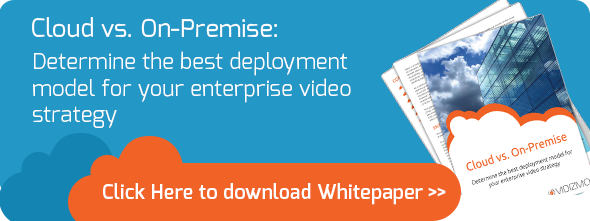As video streaming continues to increase in prominence across the enterprise, business and IT leaders feel the soaring burden of video on IT systems like never before.
In contemporary business culture, video streaming is used in a diverse set of use cases that continue to increase in number and complexity as companies explore new ways to utilize video streaming to drive business productivity. This includes streaming video’s use for corporate communication and executive messaging, training, live streaming, knowledge sharing, sales enablement, and marketing – all of which can span across organizations on a local, regional, or global scale.
However, such wide-scale use of video streaming in organizations has a significant impact on the company’s infrastructure that is not always equipped to store and process several gigabytes of streaming videos on a weekly or even daily basis. Naturally, the company’s in-house IT systems come under a lot of strain in terms of fast-dwindling storage capacities as streaming videos take up a great deal of server space for storage.
In addition to this, video processing functions like encoding and video analytics are very compute-intensive tasks, which tend to slow down the servers, especially when certain tasks are taking place simultaneously. This, in turn, puts significant pressure on IT resources to maintain on-premises servers and to keep processes running smoothly, which sometimes requires a sizable investment in expanding the infrastructure, incurring a large cost burden on business resources.
Since an organization’s video consumption can be relatively unpredictable, any spikes in demand for video streaming content can put a significant burden on existing resources, even rendering them inefficient and unproductive. To counter such issues, there is a heightened need for capacity planning which often results in over-provisioning of resources that are only utilized in times of high demand but otherwise sit idle, incurring major cost inefficiencies. Under provisioning, on the other hand, has the opposite effect where businesses could suffer from inadequate resources and a failure to deliver based on the demand.
Cloud computing offers a solution to all the above-mentioned issues as it resolves the storage burden with cloud’s infinitely elastic storage capacity, speedier encoding (which could be CDN enabled to optimize it further for a geographically dispersed audience), efficiency of drawing streaming video analytics, and overall scalability of all resources based on usage and demand, with the option to scale down anytime, as required. In addition, cloud gives businesses access to cloud innovations and the ever-evolving enterprise-grade cloud security sophistications, which sometimes cannot be met by in-house security standards.
Embrace the cloud for effective video
According to Gartner, Inc., more than $1 trillion in IT spending will be directly or indirectly affected by the shift to cloud during the next five years, making cloud computing one of the most disruptive forces of IT spending since the early days of the digital age.
Keeping in mind the above-mentioned in-house infrastructure challenges facing the enterprise, a steady move to the cloud is inevitable. With video streaming, the case for a cloud-based streaming video solution is even more compelling.
So what are the drivers propelling enterprises in favor of a cloud-based enterprise video streaming solution?
Storage flexibility: With an unlimited storage capacity, cloud video streaming gives organizations the flexibility to upscale their video consumption and storage capacity within minutes, without incurring any long-term capital expenditure. Not only that, but cloud providers can also downscale storage, as per customer’s need, so companies only pay for their specific usage, making it especially useful for organizations with an unpredictable demand for streaming video. Additionally, with sprawling cloud providers in a fast-growing market for cloud solutions, cloud storage costs continue to decrease over time. Increasing storage or streaming needs in an on-premises infrastructure, on the other hand, translates to expanding the video streaming hardware capacity, perhaps by buying, installing and configuring additional servers or replacement hardware. Naturally, there might be physical limits to how much a company can extend its on site architecture.
Content security and compliance: Cloud providers now employ the most technologically advanced and sophisticated security standards that are often superior to what individual organizations can implement in-house. Cloud providers like AWS, Microsoft Azure or IBM invest enormously in maintaining the highest cyber security measures in the industry. Additionally, cloud providers also have dedicated cyber security teams that monitor, mitigate and prevent any potential vulnerabilities. Regulatory compliance and access controls are also strictly applied to most cloud services to ensure high security. For on-premises users, such compliance certifications will have to be acquired by the organization itself.
Faster encoding: Cloud-based video encoding now offers improved speed and reliability so users can upload, view and share high-quality streaming video content for a fraction of the cost of establishing this setup in-house. Cloud-based transcoding also solves an inherent problem with streaming video size or volume unpredictability as the customer only pays for what it uses rather than buying fixed amount of data. Also, cloud-based transcoding systems have the capacity to scale infinitely in a matter of minutes while also having the ability to handle any complexities of video streaming and formatting. Additionally, cloud providers invest abundantly to maintain the latest and most advanced encoding technology standards. On-premises encoders, on the other hand, will inevitably run into capacity issues over time, and the user will need to invest in installing and maintaining oversized computing hardware to encode faster for timely delivery of video streaming.
Bandwidth management: Video streaming uses up too much bandwidth. However, over time bandwidth has increasingly become more readily available and affordable in the cloud. Additionally, most cloud providers now have advanced bandwidth management systems to reduce bandwidth consumption and promote smooth remote viewing from any device or location. Additionally, with a CDN-enabled cloud video streaming solution, bandwidth usage is significantly reduced, and users can enjoy a smooth streaming and viewing experience – all while enhancing global content availability.
Remote access: Cloud gives users access to information from any browser, device or location where there is an internet connection, allowing remote or geographically dispersed users 24/7 access to applications residing in the cloud. This gives users flexible access to all streaming video content, regardless of their device, time zone, or geographical location. Since on-premises systems are not architected for remote access, additional measures have to be taken to enable remote access, and even then, there are persisting challenges associated with encryption issues, browser incompatibilities, and media quality degradation.
Redundancy and reliability: Video streaming content stored in the cloud is usually mirrored at multiple redundant sites, making data backup, disaster recovery and business continuity fast, easy and economical. On-premises datacenters have variable redundancy levels, usually maintained by internal IT staff, resulting in slower data recovery in case of a catastrophic failure in the primary location. Moreover, the duplicate servers are often idle, adding to overhead expenses.
Total cost of ownership: With cloud-based video streaming, businesses save immensely on business overheads such as upfront capital expenditure to buy and install an on-premises infrastructure as well as the operational hardware maintenance and replacement costs. In a cloud-based streaming video set up, the initial cost is usually a low-cost bridge appliance, in addition to the monthly subscription costs, which are increasingly lower due to economies of scale from large public cloud service providers.
System support: Streaming video infrastructure can be tricky to manage. Organizations whose video streaming server reside in-house might face bottlenecks with video encoding, live streaming, technology upgrades, as well as onsite configuration and maintenance of video streaming software by expert personnel. A cloud-based video streaming solution, on the other hand, comes with both basic and premium support, simplified IT management and maintenance capabilities through central administration of resources, vendor-managed infrastructure, and SLA-backed agreements. All feature upgrades are automatically incorporated by the service provider, and the SLA ensures the timely and guaranteed delivery, management, and maintenance of IT services. For instance, VIDIZMO shared cloud model is fully managed by VIDIZMO infrastructure maintenance and support teams. The cloud infrastructure is monitored 24/7 for security and operational anomalies while maintenance and upgrades are performed periodically under scheduled maintenance windows that are communicated with all customers, detailing any expected outages, service degradation, etc. In the case of any questions or concerns, customers can contact Tier 1 support and issues can be escalated to Tier 2 and Tier 3 support.
Learn more about VIDIZMO enterprise video platform and its deployment options in the cloud, on-premises or hybrid model, contact our team for more information or sign up for a free 30-day trial today.
Posted by Rabeea Tahir
Rabea Tahir is Technology Content Strategist at VIDIZMO which is a Gartner recognized enterprise video content management system, to stream live/on-demand media to both internal and external audiences, on-premise, Azure or AWS cloud. VIDIZMO solutions are used by enterprises, government, local, state government, healthcare, law enforcement agencies, justice, public safety, manufacturing, financial & banking industry.
- Tags
- Deployment Models




